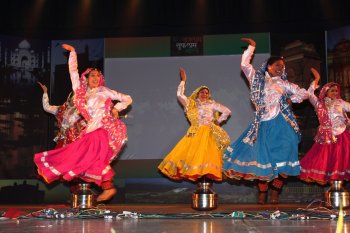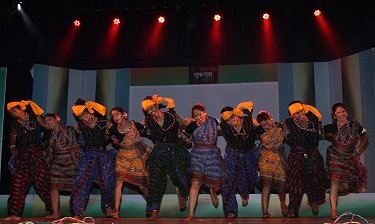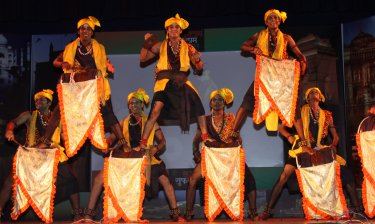
|   |

|   |
Colourful folk dance extravaganza - Vijay Shanker, Mumbai e-mail: vijaydance@gmail.com Photos courtesy: Devendra Shelar May 30, 2012 Kiran V Shantaram presented a unique folk dance program known as ‘Sujalam Sufalam Bharat’ showcasing the folk dance styles of all the 28 states at the Ravindra Natya Mandir from 7th to 9th May in Mumbai. Performed by sixty dancers from Devendra Shelar Dance Academy, it was a rhythmic delight and a rare spectacle exposing the varied cultures of the different states and the dancers danced with lot of enthusiasm and zeal. With concept and guidance from Guru Ramesh Purav and the executive director being Devendra Shelar, it was not an easy task to train and prepare the dancers. The training for over four months has ultimately come out with wonderful results. Watching the program for two and a half hours, you get to see unity in diversity, as each state has its own culture and tradition. Folk dances being the dance of the people and by the people, it is a social dance as the entire society participates, including both men and women. The dances are normally performed either on auspicious occasions like the birth of a child, marriage or the harvest season. There are dances that are also performed as temple rituals. It is interesting to note here that most of the classical dances are in some way or the other rooted in folk dances and in classical dances one can find folk elements. While folk dances are completely social, pertaining to day-to-day activities, classical dances go a step further in relating to the almighty, hence is spiritual. The announcements for each and every dance with suitable commentary in Marathi and Hindi with the audiovisuals of the particular state added colour to the entire presentation. In order to cater to a wider reach, the commentary should also be dubbed in English.  Ghoomar  Sambalpuri  Dholu Kunita While most of the dancers were trying to do their best, some of them were lagging behind; hence the team spirit was affected. Moreover in folk dances, where the movements are similar, it is essential to maintain perfect uniformity in movements which again is not easy and that needs a lot of practice. The best performed dances were Thiruvathirakali, Kolatttam, Ghoomar in which women are attired in long skirts that keeps swirling around creating a fine spectacle and the Bangra dance from Punjab which is full of joy and happiness and is normally performed during the harvest season. Prof. Kamalakar Sontakke praised the efforts of the youngsters and announced that they deserve complete encouragement. Otherwise, it is not possible to host a show of such a dimension. Kudos to the entire team. |